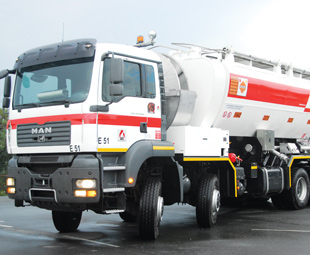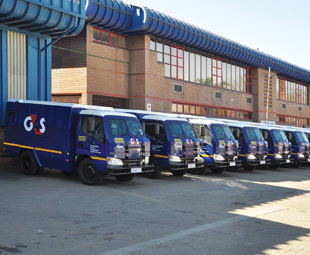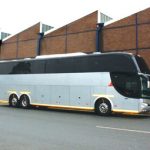South Africa is on par with the rest of the world

When it comes to designing and manufacturing specialised trucks and trailers, South African manufacturers are on par with those in the rest of the world, writes UDO RYPSTRA
While many specialised vehicle designs are developed locally, more often than not they are derivatives of overseas designs which are adapted to suit local conditions and driver peculiarities. Obviously these units would be configured to suit South African legal requirements and would therefore usually be unique to this country.
What constitutes an ordinary truck versus a “specialised vehicle” and how capable are South African manufacturers in this field? These questions were fired at Dick Garzancich, former managing director of TEE and TFM Wynberg, who is well known for having produced a wide range of trailer designs for industries such as timber, cane, dry bulk, heavy haulage, beverage, as well as airport ground support equipment.
The latter, he says, was rather specialised. These included passenger boarding steps, cabin loaders, baggage loaders, passenger assist units as well as baggage trolleys. Of particular note is that any equipment which approaches an aircraft needs to comply strictly with safety regulations, necessitating numerous interfaced lock-out systems.
Garzancich recalls a rather specialised unit manufactured for the Defence Force during the 80s, which called for a telescopic platform mounted onto a heavy duty commercial vehicle. Extreme stability was essential for the platform as it supported a radar apparatus which could be raised above tree level during border patrol.
After more than 40 year s in the business which started out with Mercedes-Benz in 1965 and later developed to the trailer industry, Garzancich recently retired from TFM Industries in Wynberg. He applied the expertise gained in the beverage industry – TFM grew to be one of the preferred suppliers which, he explains, requires a rather specialised distribution system.
s in the business which started out with Mercedes-Benz in 1965 and later developed to the trailer industry, Garzancich recently retired from TFM Industries in Wynberg. He applied the expertise gained in the beverage industry – TFM grew to be one of the preferred suppliers which, he explains, requires a rather specialised distribution system.
His experience in this industry led to the manufacture of some unique designs – in several instances a world first. He confesses that ”admittedly some ideas were gleaned from my overseas experiences. Overseas manufacturers went through the processes a long time ago, why reinvent the wheel? Trial and error is costly.”
To maintain one’s position in the trailer industry, one needs to keep abreast of technical and logistical advances. Visits to trade shows in Germany, Holland, Italy, South America as well as the UK, enables manufacturers to present ideas which meet the specific requirements for specialised equipment.
We were having coffee at a well-known cafe on Nelson Mandela Square in Sandton, observing the removal of festive lights by labourers using a telescopic platform to reach the required height.
“Now that can also be classed as a specialised unit,” quipped Linda Watson, who now focuses on another specialised industry – dry bulk tankers, catering mainly to the feed industry.
Having built up a substantial clientele over the past 30 years Linda registered her own company, Distribution Methods, 10 years ago, specialising in dry bulk tankers which Garzancich introduced from the USA in 1975. Dick recently joined Linda in this venture, adding technical impetus to further develop designs.
At this point we had already exhausted discussions around specialised vehicles which included cash-in-transit units, ambulances, concrete mixers, refuse compactors, skip loaders and mobile cranes, and moved to another interesting topic of discussion on customised Mercedes-Benz and Land Rover armoured vehicles for dignatories. Units such as these were displayed at last year’s Aerospace and Defence Force Exhibition in Cape Town.
 Wrecker/break-down vehicles, particularly “the monster type” built on, for instance, Western Star, whose crane can handle between 75 and 100 tons, are particularly specialised.
Wrecker/break-down vehicles, particularly “the monster type” built on, for instance, Western Star, whose crane can handle between 75 and 100 tons, are particularly specialised.
Cranes fitted to various truck-mounted units, such as UD, Hino, Isuzu, Mercedes-Benz, MAN, to mention but a few, prompt one to think of aerial platforms which are fitted to vehicles for use in servicing overhead power lines, street lights or other circumstances where workmen are required to be elevated many metres above the ground.
Garzancich classifies fire engines, particularly those operating at airports of the Rosenbauer type, as “highly specialised” units.
Discussions soon progressed to another significant sector – abnormal load units using push-pull truck-tractors hauling loads in excess of 100 tons. More often than not, because of their complexity, they are fully imported from companies such as Goldhoffer, Nicholas and Cometto.
These units are usually 4-in-line hydraulic steerable units with platforms which can be hydraulically raised and lowered. Garzancich recalls being involved in the manufacture of a low slung lowbed for Iscor to transport a crucible of 90-ton capacity to convey molten metal within the Iscor grounds.
Obviously, specialised vehicles are not limited to moving freight only, but for the purpose of transporting people as well. Here the list is almost endless, involving panel van and medium truck conversions into taxis, midi-school buses, ambulances, mobile clinics, mobile workshops, site offices and mobile catering units. Large trailer chassis are also used for accommodating mobile stages, restaurants, exhibition stands, to name a few.
While Japanese, Asian and European manufacturers produce taxis specifically for the taxi industry, as required by the Department of Transport, panel van conversions for other purposes are usually done by specialist OEM-approved body converters such as Angelo Cater and Bustruck.
 Ambulances are converted to tender specifications laid down by government, therefore ensuring that the highest standards and best equipment are applied or used.
Ambulances are converted to tender specifications laid down by government, therefore ensuring that the highest standards and best equipment are applied or used.
The vehicle manufacturer most prepared to build specialised trucks is UD Trucks, who have produced a considerable number of them over the 20 years that I have been visiting the Rosslyn factory. I have witnessed the production of not only mobile TB clinics, but also service trucks that can run on rail tracks and even a mobile helicopter landing pad for Eskom at Rosslyn.
Garzancich emphasises that to cater adequately for the specialised vehicle industry as well as for the transport industry at large, it is imperative to keep abreast of overseas developments. Many local manufacturers have contractual agreements with overseas manufacturers who provide the initial designs/ideas, as well as continuous upgrades. “As previously mentioned these ideas must be adjusted to cater for African conditions as well as legal compliance. Whilst not all manufacturers work on truck conversions, those that do must observe guidelines provided by the vehicle manufacturers, especially vehicles involved in conveying hazardous materials.”
Published by
Focus on Transport
focusmagsa



